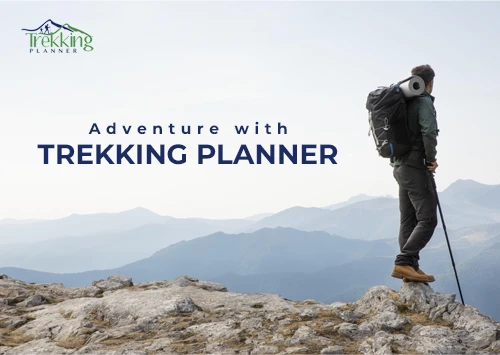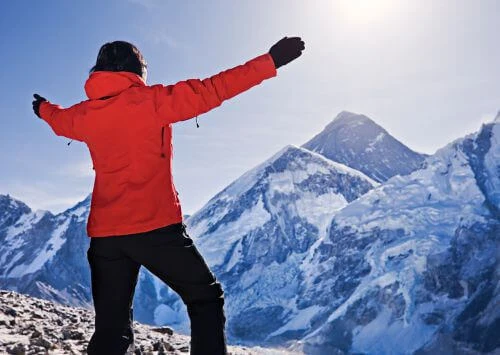Discover the Beauty of Kanchenjunga Base Camp: A Journey of a Lifetime.
Are you looking for the adventure of a lifetime that will take you to new heights? Look no further than Kanchenjunga Base Camp Trekking! Located in the remote eastern corner of Nepal, this trek offers stunning views of the third-highest mountain in the world, Kanchenjunga. It's a challenging and rewarding trek that takes you through lush valleys, dense forests, and rugged Himalayan terrain. However, the journey to Kanchenjunga Base Camp is not just about the destination but also the experience. From immersing yourself in the local culture to witnessing the breathtaking sunrise over the snow-capped peaks, this trek will leave you with memories that will last a lifetime. If you're up for the challenge, Kanchenjunga Base Camp Trekking should be on your bucket list.
So, pack your bags, lace up your boots, and prepare for an adventure you'll never forget. Don’t worry about anything; Nepal Trekking Planner is here for you.

History and significance of Kanchenjunga Mountain.
Kanchenjunga is a massive mountain range that straddles the border between Nepal and India. It is the third-highest mountain in the world, with an elevation of 8,586 meters (28,169 feet). "Kanchenjunga" means "five treasures of the snow," referring to the five peaks that make up the mountain range.
The Kanchenjunga Mountain Range is significant in Hinduism and Buddhism, as it is believed to be the abode of gods and goddesses. Many devotees undertake a pilgrimage to Kanchenjunga to seek blessings and good fortune.
Kanchenjunga Base Camp Trekking takes you through the Kanchenjunga Conservation Area, home to a diverse range of flora and fauna, including the elusive snow leopard. The conservation area was established in 1997 to protect its biodiversity and promote sustainable tourism.
Unique features of Kanchenjunga Base Camp Trekking.
Kanchenjunga Base Camp Trekking is a unique experience that offers stunning views of the snow-capped peaks and takes you through diverse landscapes. The trail passes through remote villages where you can immerse yourself in the local culture and traditions. The trek also offers a glimpse of the unique flora and fauna of the Kanchenjunga Conservation Area.
One of the trek's highlights is the sunrise view from Kanchenjunga Base Camp Trek. The sunrise over the snow-capped peaks is a breathtaking sight that awakens and inspires you. The trek also takes you through the Yalung Glacier, one of the largest glaciers in the world, which offers stunning views of the surrounding mountains.
Kanchenjunga Base Camp,Trekking Planner Nepal advises that this trek requires physical and mental preparation. It takes you through rugged Himalayan terrain, steep ascents and descents, and a high level of fitness and endurance.
The best time to go for Kanchenjunga Base Camp Trekking.
The best time for Kanchenjunga Base Camp Trekking is during the Spring (March to May) and Autumn (September to November) seasons. During these months, the weather is moderate, with clear skies and mild temperatures. The spring season offers stunning views of the blooming rhododendron forests, while the autumn season offers clear views of the snow-capped peaks.
During the Winter Months (December to February), the temperature drops significantly, and the trails may be covered in snow and ice, making trekking difficult. The Monsoon Season (June to August) brings heavy rainfall, making the trails slippery and dangerous.
Recommended Read:

Kanchenjunga Base Camp Trekking Route and Itinerary.
The Kanchenjunga Base Camp Trekking Route passes through remote villages, dense forests, and rugged Himalayan terrain. It starts from the town of Suketar in Taplejung District and takes 20–25 days to complete.
The trek is divided into the North and South Base Camps. The North Base Camp is in Tibet, while the South Base Camp is in Nepal. Most trekkers undertake the South Base Camp Trek, which takes you through the Kanchenjunga Conservation Area.
The trek starts from Suketar and takes you through the villages of Mitlung, Chirwa, Sekathum, Amjilosa, Gyabla, Ghunsa, Kambachen, Lhonak, Pangpema (Kanchenjunga Base Camp), and Ghunsa. The trail passes through dense rhododendrons, oak, and bamboo forests and offers stunning views of the snow-capped peaks.
Trekking Planner Nepal follows the itinerary mentioned below for the Kanchenjunga Base Camp Trek:
Day 1: Arrival in Kathmandu.
Day 2: A full day in Kathmandu.
Day 3: Morning flight to Taplejung.
Day 4: Lali Kharka to Kade Bhanjyang (2200m).
Day 5: Kade Bhanjyang to Phurungde (1965m).
Day 6: Phurungde to Yamphuding (2300m).
Day 7: Yamphuding to Omje Khola (2345m).
Day 8: Omje Khola to Torantan (2990m).
Day 9: Torantan to Tseram (3870m).
Day 10: Acclimatization Day in Tseram.
Day 11: Tseram to Ramche (4625m).
Day 12: Rest and Explore Around the Yalung Base Camp and Back to the Ramche.
Day 13: Ramche to Yalung (4800m).
Day 14: Yalung to Selele Pass (5109m).
Day 15: Selele Pass to Ghunsa (3425m).
Day 16: Ghunsa to Khambachen (3960m).
Day 17: Khambachen to Pangpema (4940m).
Day 18: Day hike to the Kanchenjunga Base Camp and back to Pangpema.
Day 19: Pangpema to Khambachen.
Day 20: Khambachen to Ghunsa.
Day 21: Ghunsa to Kyapra.
Day 22: Kyapra to Sekhathum.
Day 23: Sekhathum to Chirwa.
Day 24: Chirwa to Phurumba (2000m).
Day 25: Phurumba to Suketar (Taplejung).
Day 26: Fly back to Kathmandu.
Day 27: Departure from Kathmandu.
Safety Measures to Keep in Mind During the Trek.
Kanchenjunga Base Camp Trekking is a challenging trek that requires physical and mental preparation. Trekking planner Nepal advises keeping the following safety protocols for travelers during the trek:
- Stay Hydrated: It is essential to drink plenty of fluids to avoid dehydration, especially at higher altitudes.
- Acclimatize Properly: The trek takes you to high altitudes, which can cause altitude sickness. It is essential to acclimatize correctly and take adequate rest.
- Follow the Trail: The trail is well-marked, and it is essential to follow the trail to avoid getting lost.
- Carry Essential Items: You must carry essential items for trekking, such as warm clothing, sleeping bags, a first aid kit, and trekking poles.
- Hire a Guide: You should hire a guide for the trek. They are familiar with the trail and can provide valuable insights into the local culture and traditions.
Essential items to pack for Kanchenjunga Base Camp Trekking.
Kanchenjunga Base Camp Trekking requires proper planning and preparation. It is essential to pack the following items for the trek:
- Warm Clothing: The trek takes you to high altitudes, where the temperature can drop significantly. Warm clothing such as fleece jackets, gloves, and hats is essential.
- Sleeping Bag: It is essential to carry a warm sleeping bag, as the nights can be cold at higher altitudes.
- First Aid Kit: A first aid kit with essential medicines, bandages, and antiseptics is essential.
- Trekking Poles: Trekking poles provide support and balance and can help reduce the strain on your knees and ankles.
- Water Bottle: Staying hydrated during the trek is essential, and a water bottle is a must.
Recommended Read:
Accommodation and Food Options During the Trek.
Kanchenjunga Base Camp Trekking offers a range of accommodation options, including teahouses and camping. Teahouses are basic lodges offering rooms with amenities such as a bed, blanket, and pillow. Camping is an option for those who prefer a more adventurous experience.
Food options during the trek include traditional Nepali cuisines such as dal bhat (rice and lentils), momos (dumplings), and thukpa (noodle soup). Vegetarian and non-vegetarian options are available.
Local Culture and Traditions of the Kanchenjunga Region.
The Kanchenjunga Region is home to diverse ethnic groups, including the Limbu, Sherpa, and Rai communities. Nepal's local culture and traditions are rich and unique, and the trek offers an opportunity to immerse yourself in the local way of life.
The local communities are friendly and hospitable, and many trekkers opt for a homestay experience, where they stay with a local family and learn about their culture and traditions.
Benefits of Kanchenjunga Base Camp Trekking for Mental and Physical Health.
Kanchenjunga Base Camp Trekking offers numerous benefits for mental and physical health. The trek is a challenging and rewarding experience that helps build endurance, strength, and resilience. Trekking planner Nepal offers an opportunity to disconnect from the digital world and connect with nature, which can positively impact mental health.
Kanchenjunga Base Camp Trekking also offers an opportunity to learn about the local culture and traditions, which can broaden your perspective and promote cultural understanding.
Conclusion.
According to Trekking planners in Nepal, Kanchenjunga Base Camp Trekking is a unique and challenging adventure that offers stunning views of the snow-capped peaks and takes you through diverse landscapes. The trek requires physical and mental preparation, but the rewards are worthwhile. From the sunrise view from Kanchenjunga Base Camp to the local culture and traditions, the trek offers an experience that will last a lifetime. So, pack your bags, lace up your boots, and prepare for the adventure of a lifetime. Kanchenjunga Base Camp Trekking is waiting for you.
FAQS
Why is Kanchenjunga Base Camp famous?
Kanchenjunga Base Camp is famous for its breathtaking scenery and remote location. As the base camp for the third-highest mountain in the world, it offers stunning views of Kanchenjunga’s towering peaks and the surrounding Himalayan range. The trek is renowned for its pristine landscapes, diverse wildlife, and the opportunity to experience the rich cultural heritage of the local communities.
What is the significance of Kanchenjunga?
Kanchenjunga is the third-highest mountain in the world, standing at 8,586 meters (28,169 feet). It is revered for its sheer height and its spiritual importance in the local cultures. The region's people consider the mountain sacred, and its majestic presence symbolizes strength and grandeur.
Is the Kanchenjunga Base Camp Trek difficult?
Yes, the Kanchenjunga Base Camp Trek is considered challenging. It involves navigating rough terrain, high altitudes, and varying weather conditions. Trekkers must be in good physical condition and prepared for long days of hiking. Acclimatization and proper preparation are crucial for successfully completing this trek.
What is the difference between Everest Base Camp and Kanchenjunga Base Camp?
The main difference between Everest Base Camp and Kanchenjunga Base Camp lies in their location and experience. Everest Base Camp is more accessible and frequented by trekkers, offering iconic views of Everest and surrounding peaks. In contrast, Kanchenjunga Base Camp provides a more remote and tranquil experience, with stunning views of Kanchenjunga and fewer crowds, making it ideal for those seeking solitude and adventure.
How tall is Kanchenjunga Base Camp?
Kanchenjunga Base Camp is situated at an altitude of approximately 5,143 meters (16,873 feet). This high altitude offers incredible views of Kanchenjunga and the surrounding Himalayan range, making it a remarkable destination for trekking enthusiasts.





